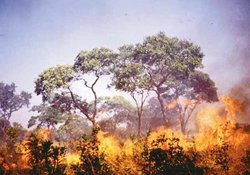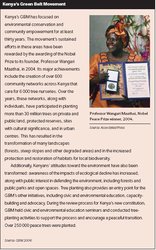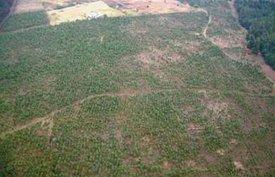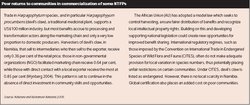Forests and woodlands and development challenges in Africa
Contents
- 1 Introduction: Challenges faced in realizing opportunities for development Figure 1. Moroccan women cleaning argan tree nuts for medicinal oil production. (Source: Y. Katerere) The endowment value of forests (Forests and woodlands in Africa) and woodlands in Africa (Forests and woodlands and development challenges in Africa) is enormous, and can be used to promote a wide range of livelihood opportunities, including increased income and enhanced livelihood security. However, as forests and woodlands are declining, primarily as a result of increased woodfuel collection, clearing of forests for agriculture, illegal and poorly regulated timber extraction, conflicts, increasing urbanization and industrialization, these opportunities are diminishing. Between 1990 and 2000, Africa’s forests and woodlands receded faster than the global average; deforestation in Africa took place at an average of 0.8 percent, as compared to the world average of 0.2 percent.
- 2 Strategies to improve opportunities
- 3 Further reading
Introduction: Challenges faced in realizing opportunities for development Figure 1. Moroccan women cleaning argan tree nuts for medicinal oil production. (Source: Y. Katerere) The endowment value of forests (Forests and woodlands in Africa) and woodlands in Africa (Forests and woodlands and development challenges in Africa) is enormous, and can be used to promote a wide range of livelihood opportunities, including increased income and enhanced livelihood security. However, as forests and woodlands are declining, primarily as a result of increased woodfuel collection, clearing of forests for agriculture, illegal and poorly regulated timber extraction, conflicts, increasing urbanization and industrialization, these opportunities are diminishing. Between 1990 and 2000, Africa’s forests and woodlands receded faster than the global average; deforestation in Africa took place at an average of 0.8 percent, as compared to the world average of 0.2 percent.
Policy, legal, institutional, technical and economic constraints have undermined wider adoption of sustainable forest management as well as limited opportunities for development.
One major constraint is that Africa has not been able to take advantage of its wealth of raw materials and traditional knowledge to invest in processing. This continues to undermine opportunities for employment and income generation. With increasing private-sector involvement, including foreign-based companies, there is a good opportunity for governments to foster viable partnerships with the communities and civil societies in the protection of traditional rights of forest-adjacent communities, and equitable sharing of benefits from forest resources to promote livelihood security and ensure sustainable use of forest and woodland resources. This is consistent with obligations under the Convention on Biological Diversity (CBD). Additionally, it is essential for there to be increased investment in the development of micro- and small and medium enterprises (SMEs) if people are to have the opportunity to move away from subsistence-based livelihoods.
Market development
 Figure 2. Processing timber in a sawmill. (Source: P. Reidar/CIFOR)
Figure 2. Processing timber in a sawmill. (Source: P. Reidar/CIFOR) The opportunities for local people to participate directly in the market are hampered by poor infrastructure, poor access to financial and other support, as well as inadequate opportunity to develop micro- and small and medium enterprises (SMEs). If opportunities for new and existing business are to be increased these factors requires urgent attention. One missed opportunity is non-timber forest products (NTFPs). The full range of benefits available from the commercialization of NTFPs has not been realized. One challenge is that the returns to producer communities are often very low. This is a result of a combination of factors including low product price, high producer dependency on market intermediaries, the lack of technical and financial support, non-supportive legal and regulatory framework, and the poor relationship between final product price and production cost. This is demonstrated in relation to Harpagophytum species, and in particular Harpagophytum procumbens (devil’s claw), which forms the basis of trade in Southern Africa (Figure 3).
The successful marketing of NTFPs remains a challenge and in particular the high cost of product promotion, the high availability of substitutes, the lack of access to market information, the lack of contact with final consumers, the lack of financial instruments, the lack of technical support, inadequate community organization, lack of market value, poor quality control, lack of attractive product presentation, lack of management capacity and poor understanding of consumer demands and needs. Low investment in production processes undermines efficiency and results in higher product costs, making the final products uncompetitive globally. Additional constraints to developing pro-poor markets include insecure tenure and the free availability of genetic resources in gene banks. Table 2 sets out some of the impacts of markets on household assets. Weak management, monitoring and evaluation systems and weak institutions have paved way for large-scale illegal logging in many countries. Throughout Africa, forestry departments are experiencing acute shortage of staff and equipments. Forestry education has also declined over the past two decades; the situation is made worse by declining donor investments.
Political instability and budget problems have also forced many institutions to close for long periods–one consequence of this is that there is an acute shortage of trained forest (Forestry)ry practitioners. A report by the Food and Agriculture Organization of the United Nations (FAO) and the World Conservation Union (IUCN) shows a particularly worrying situation in Central Africa (Central Africa and forests and woodlands), which has the richest forests in the region. The Democratic Republic of the Congo (DRC), for example, has only 100 professional foresters to manage forests covering an area three times the size of France. Congo’s faculty of forestry was ransacked in 1997/98 and only reopened in 2002. The Central African Republic’s faculty was also pillaged.
Conflict and war
Another challenge for forest (Forestry) management is conflict and war. In many conflict areas, forest management has been suspended and illegal loggers, even if not directly involved in the conflicts, have at times devastated forest resources. Post-conflict periods do not necessarily lead to more sustainable systems. There may, for example, be an increased demand for wood during post-conflict reconstruction which can worsen the situation.
Agricultural pressures
Although 5 percent of Africa’s forests are designated as protected areas, the management accorded to the areas is not commensurate with their conservation status. Encroachment, illegal logging, grazing and poaching of wild animals persist in these areas. Agricultural expansion and overgrazing are also an increasing problem and major causes of the loss of woody vegetation cover, especially in Eastern, Southern and Western Africa. Given the high dependence on agriculture, there is growing pressure to increase the area under agriculture to meet the food requirements of the growing population at the expense of forests. The ongoing land reforms in Southern Africa have seen movement of commercial farmers from Zimbabwe and South Africa to Mozambique and Zambia, and countries outside the Southern African Development Community (SADC) region. This development could potentially reduce forest cover in the recipient countries. Newly-settled farmers also tend to open up new land for crop cultivation.
Fire
 Figure 4. Dry season forest fire, Zimbabwe.(Source: P. Frost/CIFOR)
Figure 4. Dry season forest fire, Zimbabwe.(Source: P. Frost/CIFOR) Bush fires are another threat to forests (Forests and woodlands in Africa) and woodlands, causing enormous destruction to both flora and fauna. The total global area burned annually between 2002 and 2003 was in the range of 300 to 400 million hectares (ha), and about half of this was in Africa. The combination of the above pressures on forests has resulted in the decline in both the quality and quantity of forest and woodland resources. Between 1990 and 2000, Africa lost about 52 million ha of forest, accounting for about 56 percent of the global reduction in forest cover. Southern Africa accounted for about 31 percent of the forest loss on the continent. Three countries, namely Sudan, Zambia and the DRC, accounted for almost 44 percent of Africa’s deforestation. Deforestation is particularly rampant outside protected areas, especially where regulatory and enforcement frameworks are inadequate. In many rural areas, there has been a breakdown in traditional community arrangements and this has, in the face of no alternative regulatory system, contributed to poor management.
Strategies to improve opportunities
Improved regional collaboration and harmonization of approaches
Africa recognizes the immense value of its forests (Forests and woodlands in Africa) and has mainstreamed forests in its development agenda, the New Partnership for Africa’s Development (NEPAD). The NEPAD Environment Action Plan (NEPAD-EAP) locates forests and woodlands in Programme Area 6: Transboundary conservation or management of natural resources, which emphasizes the protection and sustainable management of Africa’s forest resources through:
- Strengthening national plans and programs for forest (Forestry) management, inventory and monitoring. This includes improving the participation of stakeholders, such as communities and the private sector, in new approaches and initiatives as well as the promotion of the wide range of roles played by forests. Also included here are measures to improve and integrate mapping and knowledge (scientific as well as traditional knowledge) and to strengthen monitoring and assessment.
- Maintaining protected areas by, among other measures, improving capacities, forming collaborative management partnerships with other countries, and restoring ecosystems; and
- Strengthening forest law and governance, by encouraging the sharing of information on trade in illegally harvested forest products, improving participation in international fora and international agreements, and more effective implementation of measures to reduce corruption.
The NEPAD-EAP recognizes that forests (Forests and woodlands in Africa) and woodlands are an important crosscutting issue critical to the success of the other NEPAD programs, including combating land degradation (Land degradation and desertification in Africa) and climate change (Climate change and development challenges in Africa), and conserving wetlands, and coastal and freshwater resources. Special attention, therefore, needs to be given to enhancing the quality of forest resources at the sub-regional and national levels and to maximizing the benefits that can be derived from forests and woodlands.
In the recent past, most countries have developed policies that can support and influence sustainable use of forest and woodland resources, including national environment action plans and national sustainable development strategies. These policies aim at sound sustainable development by reconciling economic development (Economic change in Africa) and conservation of resources, and they provide a good basis for the proper management of natural resources. Their effective implementation is among the best opportunities African countries have to conserve their woodland resources and maximize benefits for their citizens.
Other measures to reduce the loss of forests include integrated land-use planning; conservation and sustainable use of natural and planted forests; community involvement in all aspects of forest (Forestry) management; developing markets for a wider range of forest goods and services, including carbon sequestration and watershed protection services; and independent third-party certification of products from sustainably managed forests.
Forestation and reforestation
 Figure 5. Kenya's Green Belt Movement. (Source: Green Belt Movement 2006)
Figure 5. Kenya's Green Belt Movement. (Source: Green Belt Movement 2006) Some countries have adopted aggressive programs of forestation and reforestation, with demonstrated results in the short run. As a result of these efforts, the annual planting rate in Africa overall is estimated at 194,000 hectares (ha) or about 4.4 percent of the global planting rate.
In the Western Indian Ocean (WIO) island states, for example, vegetation cover is changing considerably through the development of agroforestry plantations. The Seychelles has extensive coconut plantations as well as a relatively large planted estate of Casuarina and Albizia species. Both Cape Verde (9.3 percent) and Gambia (1.0 percent) show increases in forest cover. Similarly, there is a positive trend in Northern Africa, with Egypt experiencing a growth of 3.3 percent, Libya 1.4 percent and Tunisia 0.2 percent.
As natural forest areas shrink, the concern to conserve the remaining areas for environmental services has resulted in many countries setting them aside as protected areas, thus making them largely unavailable for commercial exploitation. This has led to a push to expand the plantation areas, especially in South Africa, Swaziland and Zimbabwe. Swaziland has experienced a growth of 1.2 percent. There is also increased private planting in Eastern and Western Africa. Some countries, like Uganda, are actively seeking the involvement of the private sector in plantation development, including establishing a loan scheme by the National Forestry Authority for tree farmers and offering leases on its own reserve land to encourage private plantations development. Nevertheless, Uganda’s forest cover continues to decline at a rate of 2 percent per year.
Community empowerment
Improving the opportunities available to local users will have benefits at the local level, with potentially positive spin-offs at the national, sub-regional and regional level. The importance of community and public involvement in the management of forests has been recognized and promoted across Africa, with many countries adopting new laws and policies to support this. There is increased community involvement in several sectors including forest (Forestry) management, ecotourism, advocacy, public education, and forestation and reforestation. Governments are also increasingly recognizing the value local users bring to resource management as their primary custodians.
Non-governmental organizations, such as the Green Belt Movement (GBM) in Kenya, have played an important role in promoting such approaches, as shown in Figure 5.
Human resource capacity
Human resources development, particularly in terms of professional training, has not been sufficient to meet the needs associated with sustainable management and enhancing development opportunities.
Investment in forest-related education is an important challenge. From 1993 to 2002, the number of forest (Forestry)ry bachelor degrees awarded has been increasing steadily, but the number of post-graduate degrees has declined significantly. Certificate-level forestry training has practically disappeared. International partnerships can play a key role in addressing this problem. One option is to increase the opportunity for African students to study in developed countries.
Agroforestry
While forests are valued for their timber, fruits and medicinal values, the opportunity presented by agroforestry to communities in the region is not well known. Agroforestry technologies that can be readily adopted include planting of nitrogen-fixing trees, the domestication of indigenous fruit trees, medicinal trees, live fences, and woodlots for timber and fuelwood. Regional cooperation, including through sharing experiences and lessons on effective resource management, may improve opportunities. The strengthening of the East African Community, for instance, is a good opportunity for improved cooperation between Uganda, Kenya, Tanzania, Rwanda and Burundi.
Economic and development opportunities
The extent and quality of [[forests (Forests and woodlands in Africa)] and woodland] varies from one sub-region to the other as does their socioeconomic significance. The sub-regional analysis discusses the various issues related to sustainable management of the forests and woodlands at this level and the various strategies being put in place to optimize benefits and ensure sustainability. A multilevel strategy for harnessing opportunities, which brings in multiple actors and focuses on improving opportunities for local users, increasing investment in value-adding activities, and utilizing the opportunities for environmental service markets, is essential.
 Young forest plantation on Mount Kilimanjaro, Tanzania. (Source: C. Lambrechts/UNEP)
Young forest plantation on Mount Kilimanjaro, Tanzania. (Source: C. Lambrechts/UNEP) There are several possible levels of economic activities involving local communities, including in small-scale income-generating, cooperative projects, and large-scale partnership projects with the private sector. Effective local level management of natural resources requires that local people have clear, unambiguous proprietary rights to the resources they manage. For communities to take advantage of emerging opportunities, a policy and legislative framework is required that protects the communities’ rights to forest resources, promotes access to markets, ensures proximity to markets, improves local expertise, gives access to information, improves institutional capacity to manage resources, adds value to products and services, increases the negotiation capacity of local people, and promotes partnership.
The proportion of logs domestically processed in Africa increased slightly from 80 percent in 2003 to 82 percent in 2004. This reflects increasing populations, growing economies and the emphasis on producing and exporting value-added products in this region. South Africa accounts for about 42 percent of Africa’s share of value-added wood industries. Other African countries’ share in processing is considerably lower. According to FAO’s Global Forest Resources Assessment 2005, the wood industry’s gross added value stems from wood processing rather than wood availability. Ultimately, it is the improvement of and access to technology that will enhance the value-adding, manufacturing and marketing performance of the wood industry. The World Summit on Sustainable Development (WSSD) in its Johannesburg Plan of Implementation prioritized investment in industry as critical to meeting sustainable development goals.
If the existence of large forest areas is neither an essential nor a sufficient condition for the promotion of dynamic forest industries in Africa, it most certainly is for the expansion of schemes such as the Clean Development Mechanism (CDM) that focus on the carbon sequestration value of forests. This market has been evolving quickly, but Africa has not seized the opportunities available through it. Forestation and reforestation schemes can be an important component of carbon trade as envisaged under the Kyoto Protocol. In order to maximize the benefits from CDM-related activities, African nations must ensure that more land is available for forestation and reforestation, and that forest conservation and sustainable management activities are pursued. Increasing the availability of forests for carbon sequestration also implies that more carbon market traders will come into play, boost competition, thus motivating countries to sustain management and conservation activities.
Further reading
- FAO, 2002. Global Forest Resources Assessment 2000 – Main Report. FAO Forestry Paper No. 140. Food and Agriculture Organization of the United Nations, Rome.
- FAO, 2003. Forestry Outlook Study for Africa African Development Bank, European Commission and the Food and Agriculture Organization of the United Nations, Rome.
- FAO, 2005. Food and Agriculture Organization of the United Nations, Rome.
- FAO, 2006. FAO Forestry Paper No. 147. Food and Agriculture Organization of the United Nations, Rome.
- FAO, ANAFE and SEANAFE, 2005. Forestry Education in Sub-Saharan Africa and Southeast Asia: Trends, myths and realities, by August B. Temu, Per G. Rudebjer, James Kiyiapi and Pieter van Lierop. Forestry Policy and Institutions Working Paper No. 3. Rome.
- FAO, RIFFEAC and UICN, 2003. Evaluation des besoins en formation dans le secteur forestier en Afrique Centrale. l’Organisation des Nations Unies pour l’alimentation et l’agriculture, Réseau des institutions de formation forestière et environnementale d’Afrique Centrale, UICN – Union mondiale pour la nature. Food and Agriculture Organization of the United Nations, Rome.
- ITTO, 2004. Annual Review and Assessment of the World Timber Situation. International Tropical Timber Organization, Yokohama.
- Katerere, Y. and Mohamed-Katerere, J. C., 2005. From Poverty to Prosperity: Harnessing the Wealth of Africa’s Forests. Forests in the Global Balance – Changing Paradigms, pp 185-208. IUFRO World Series Vol. 17. International Union of Forest Research Organizations, Helsinki.
- Landell-Mills, N. and Porras, I.T., 2002. Silver Bullet or Fools’ Gold? A Global Review of Markets for Forest Environmental Services and their Impact on the Poor. Instruments for Sustainable Private Sector Forestry Series. International Institute for Environment and Development, London.
- Marshall, E., Newton, A.C. and Schreckenberg, K., 2003. Commercialisation of non-timber forest products: first steps in analysing the factors influencing success. International Forestry Review 5(2):128-37.
- UNEP, 2005. Atlantic and Indian Oceans Environment Outlook. United Nations Environment Programme, Nairobi.
- UNEP, 2006. Africa Environment Outlook 2
|
|
| Disclaimer: This article is taken wholly from, or contains information that was originally published by, the United Nations Environment Programme. Topic editors and authors for the Encyclopedia of Earth may have edited its content or added new information. The use of information from the United Nations Environment Programme should not be construed as support for or endorsement by that organization for any new information added by EoE personnel, or for any editing of the original content. |
